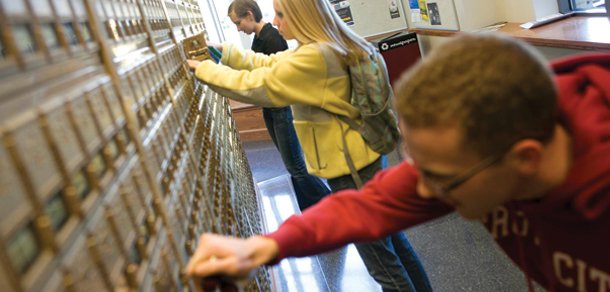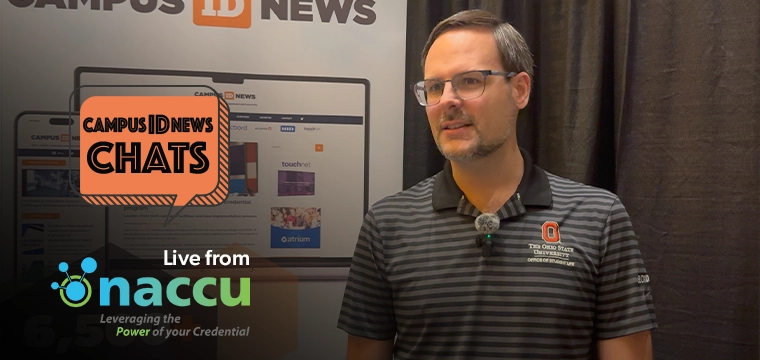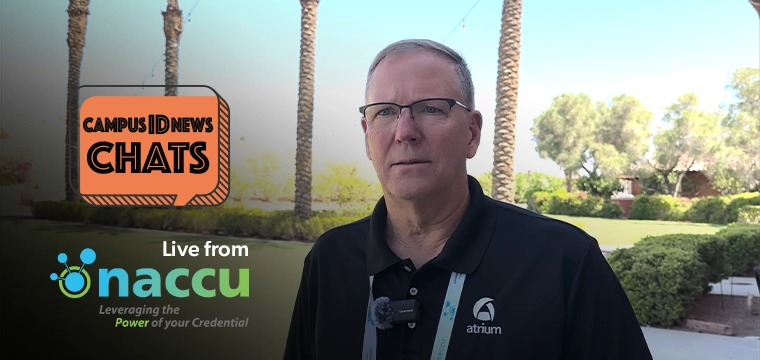
Automation, mobile app reduces footprint and improves student service
As a result of the convenience of nearly anytime, anywhere mail service the university has seen a successful and speedy mail pickup record. “For packages, we see 74% picked up on day one, and by day two a further 24% are picked up,” he says. “Only 2% of the total packages aren’t picked up within 48 hours. No other campus is coming close to that number.”
[pullquote]For packages, we see 74% picked up on day one and a further 24% by day two. Only 2% aren’t picked up within 48 hours. No other campus is coming close to that number.[/pullquote]
The reason for pursuing the more automated system was to both improve the existing process and cut the considerable footprint that the campus’ several hundred mailboxes were consuming. “When the university requested to take a sizeable amount of our mail space we decided to use that as an opportunity,” says McCarty.
Also key to the efficiency of ETSU’s mail operations is the automation that’s in place to facilitate student services, namely a smart locker system. The smart locker system resides in a lobby that is centrally located on campus and is available until 2:00 am daily and opens every morning at 6:00 am. As part of that system, ETSU has installed 140 intelligent lockers in four different sizes.
“We take packages from the mail truck and put them straight to the smart lockers, we scan the bar code, close the door and send the notification to the student that mail is waiting for them,” explains McCarty. “The student then reports to the mail center, visits one of the unattended monitors, enters their PIN and the door magically opens up. Students retrieve their package, close the door, and are sent a confirmation email informing them that they should have received their package.”
The next step for ETSU is to leverage iCollegeMail to extend the smart locker concept to letter mail as well. Other systems that do away with individual mailboxes typically sort and hold mail behind a counter and require students to report to a service window for pickup. ETSU will instead implement letterboxes that are tied to the existing intelligent locker system.
“We’re going to install 400 letterboxes directly into the wall and back load them from behind,” says McCarty. “An email will be sent out letting students know they have a letter and which box number it is in.”
Where iCollegeMail comes in, McCarty says, is in the automation of the process. Instead of manually typing student information in, those letters go through a scanner that recognizes the number and name of the student to receive the iCollegeMail notification that will also include a PIN number and a box number.
“Now with the app, students receive a push notification,” says McCarty. He says they are investigating options to eliminate the PIN-entry requirement. These could include phone-based proximity technologies – NFC, Bluetooth or GPS – as well as campus card controlled access.
Another key aspect of the iCollegeMail system is an opportunity to forge new revenue streams through digital mailers. “Unlike email, the digital mailbox is a controlled environment, and the campus mail center is the gatekeeper,” explains USZoom’s Gesserman. “So just like an image of an envelope or package can be inserted via the system, so can a PDF, enabling an entirely new messaging capability.”
Whether it’s internal communication for publicizing campus events and groups, or advertisements from local vendors, the task can be done digitally as opposed to manually printing and stuffing flyers into individual boxes, Gesserman explains.
It’s a feature of iCollegeMail that ETSU is trialing with local McDonald’s locations that are offering email discounts in the form of PDF, says McCarty. “Paper coupons almost always end up right in the trashcan, but these coupons, particularly for things like buy-one-get-one food offers, can be like gold for students.”
The mailbox of the future is digital
With iCollegeMail, every student gets a digital mailbox and app and the mail center gets admin software that enables two-way communication, says Barry Gesserman, chief marketing officer at USZoom. “Students can then see a picture of the outside of the envelope or package and manage mail from a menu of action steps.”
Simply put, the digital mailbox eliminates the need for a physical mailbox – a feature that campuses operating in tight spaces will appreciate. “A number of campuses are ripping out mailboxes because they’re seeing that it’s a waste of space,” he says.
Also available is an open and scan service that sees mailroom staff open letters, scan the contents and send a PDF file on to students via email. It’s a service that is entirely opt-in.
For packages that may contain perishable items, a priority flag can be activated, so that flowers don’t wilt and cookies from home don’t go stale, says Gesserman. “Students know exactly what item they received by viewing the image in their digital mailbox, including sender information, and can use the app to schedule a time to pick up their package.”
Students can be notified in two primary ways: push notification to the smartphone via the iCollegeMail app and email to a designated address. “Text or email messages can easily get lost or overlooked, so push notification to the app is often preferable. Plus all the mail they receive is stored in their mail history viewable from the app.”
The system enables local businesses to send a picture or a coupon right to students mobile device and bring in a little more money to the university. “It’s a chance to raise a little bit of income, provide a service to students and save time associated with stuffing the paper coupons into each mail slot and then removing them when students don’t pick them up,” he adds. “With this system students can redeemed offers using their phone, rather than losing or forgetting the paper coupon.”
Another area for potential revenue is the ability to stay connected with alumni. “Even after moving around, campuses could still get mail to their graduating alumni with this platform,” says Gesserman.
Additionally, automated systems enable the extension of mail services to off-campus students, a missed opportunity in terms of revenue, he notes.
For now ETSU graduates will continue to receive ETSU mail service for up to six months after graduation, at which point they would have the option to pay for USZoom’s standard offering.
The change that is beginning to occur in campus mail is a natural evolution of a near age-old service. As the demands placed on mail delivery change with a new generation of students who aren’t thinking about snail mail, the service itself must adapt.
The key to evolving the mail center at ETSU has been a positive, trusting relationship between staff and campus administration. “Every initiative that I’ve come up with, my higher ups have been behind it,” says McCarty. “I love providing these services and saving the university time and money.”




